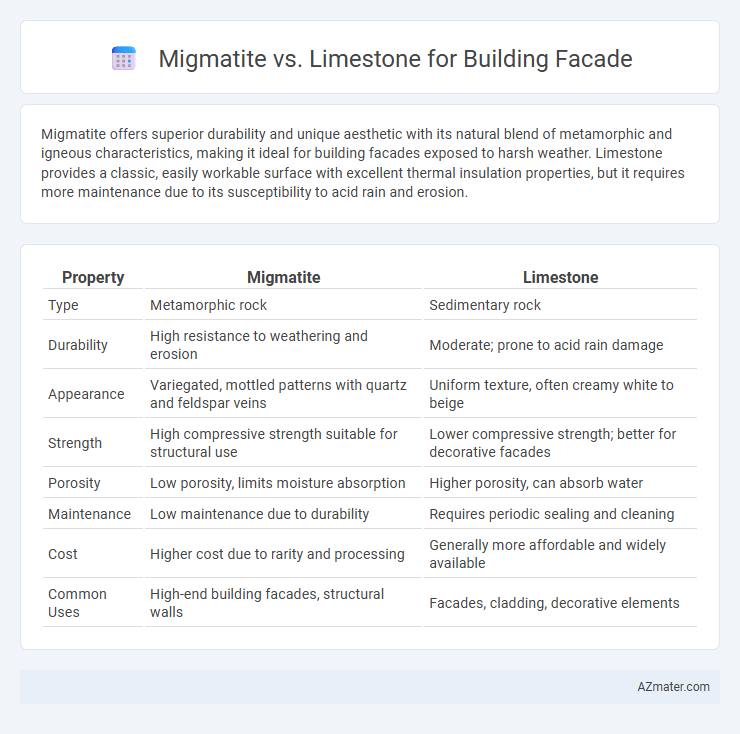Migmatite offers superior durability and unique aesthetic with its natural blend of metamorphic and igneous characteristics, making it ideal for building facades exposed to harsh weather. Limestone provides a classic, easily workable surface with excellent thermal insulation properties, but it requires more maintenance due to its susceptibility to acid rain and erosion.
Table of Comparison
| Property | Migmatite | Limestone |
|---|---|---|
| Type | Metamorphic rock | Sedimentary rock |
| Durability | High resistance to weathering and erosion | Moderate; prone to acid rain damage |
| Appearance | Variegated, mottled patterns with quartz and feldspar veins | Uniform texture, often creamy white to beige |
| Strength | High compressive strength suitable for structural use | Lower compressive strength; better for decorative facades |
| Porosity | Low porosity, limits moisture absorption | Higher porosity, can absorb water |
| Maintenance | Low maintenance due to durability | Requires periodic sealing and cleaning |
| Cost | Higher cost due to rarity and processing | Generally more affordable and widely available |
| Common Uses | High-end building facades, structural walls | Facades, cladding, decorative elements |
Introduction to Migmatite and Limestone
Migmatite is a composite rock consisting of metamorphic and igneous components, known for its distinctive banded appearance and high durability, making it suitable for building facades requiring strength and unique aesthetics. Limestone, a sedimentary rock composed mainly of calcite, offers a classic and versatile look with excellent workability but is more susceptible to weathering and acid rain compared to migmatite. Both materials provide distinct visual and structural properties that influence their selection for architectural facades.
Geological Origins and Composition
Migmatite originates from high-grade metamorphism where igneous and metamorphic processes partially melt the rock, resulting in a heterogeneous texture of quartz, feldspar, and mica. Limestone forms primarily from accumulated marine biogenic debris, mainly composed of calcite (CaCO3) derived from skeletal fragments of marine organisms. The complex mineralogical composition of migmatite offers superior durability and aesthetic variation compared to the predominantly calcitic, softer, and more chemically reactive limestone in building facades.
Aesthetic Appeal: Texture and Color Variations
Migmatite offers a striking aesthetic appeal with its unique blend of dark and light mineral bands, creating intricate swirling patterns and a natural marbled effect that adds depth and character to building facades. Limestone provides a more uniform and subtle texture, available in a range of soft tones from creamy whites to warm beige, creating an elegant and timeless appearance. The varied textures and bold color contrasts in migmatite make it ideal for dynamic, eye-catching designs, while limestone's consistent and smooth surface lends itself to classic and refined architectural styles.
Durability and Weather Resistance
Migmatite offers superior durability and weather resistance for building facades due to its hybrid metamorphic composition, combining the strength of both igneous and metamorphic rocks, which resists cracking and erosion. Limestone, while aesthetically appealing with its uniform texture and color, tends to be more porous and susceptible to acid rain and freeze-thaw cycles, leading to faster degradation over time. The denser structure of migmatite ensures longer-lasting facades with minimal maintenance in harsh environmental conditions compared to the more vulnerable limestone surfaces.
Workability and Ease of Fabrication
Migmatite offers superior workability for building facades due to its composite nature, allowing easier cutting and shaping compared to limestone's relatively brittle and homogeneous structure. Limestone, while aesthetically appealing, requires more careful handling and specialized tools to avoid chipping during fabrication. The variability in migmatite's mineral composition enhances adaptability in complex designs, making it favorable for detailed architectural elements.
Environmental Impact and Sustainability
Migmatite offers higher durability and weather resistance for building facades, reducing long-term maintenance and resource consumption compared to limestone, which is prone to erosion and requires frequent repairs. Limestone extraction involves intensive quarrying that disrupts local ecosystems and produces significant carbon emissions, whereas migmatite's extraction is less environmentally invasive due to its geological distribution and hardness. Using migmatite enhances sustainability by extending facade lifespan and lowering environmental degradation, making it a preferable material in eco-conscious construction.
Thermal and Acoustic Performance
Migmatite offers superior thermal insulation compared to limestone due to its dense and heterogeneous mineral composition, which reduces heat transfer through building facades. Limestone, while aesthetically versatile, exhibits higher thermal conductivity, leading to less effective temperature regulation in exterior cladding. In terms of acoustic performance, migmatite's variable texture and density enhance sound attenuation, making it more efficient at dampening external noise than the more porous and uniform structure of limestone.
Cost Comparison and Availability
Migmatite offers higher durability and aesthetic appeal but comes with a higher initial cost, typically ranging from $50 to $100 per square foot, compared to limestone's more affordable price of $30 to $60 per square foot. Limestone is widely available and easier to source in many regions, making it a cost-effective option for large-scale projects. Availability of migmatite is more limited and often requires specialized quarrying, which can increase transportation and handling expenses.
Iconic Buildings Featuring Migmatite and Limestone
Migmatite is prized in building facades for its unique blend of igneous and metamorphic textures, as showcased by the Sydney Opera House, where its intricate patterns enhance aesthetic appeal and durability. Limestone, favored for its classic elegance and workability, is prominently featured in iconic structures like the Empire State Building, adding timeless beauty and structural strength. Both materials offer distinct visual and physical properties, contributing to the architectural identity and longevity of renowned landmarks worldwide.
Choosing the Right Stone for Your Facade
Migmatite offers superior durability and a unique, variegated appearance due to its metamorphic origins, making it ideal for modern building facades requiring resilience against weathering. Limestone, prized for its natural warmth and ease of carving, provides a classic aesthetic but may demand more maintenance in harsh climates due to its susceptibility to erosion and acid rain. Selecting the right stone depends on balancing aesthetic preferences with long-term performance needs, where migmatite suits high-traffic, exposed environments, and limestone fits decorative, sheltered facades.

Infographic: Migmatite vs Limestone for Building Facade
 azmater.com
azmater.com